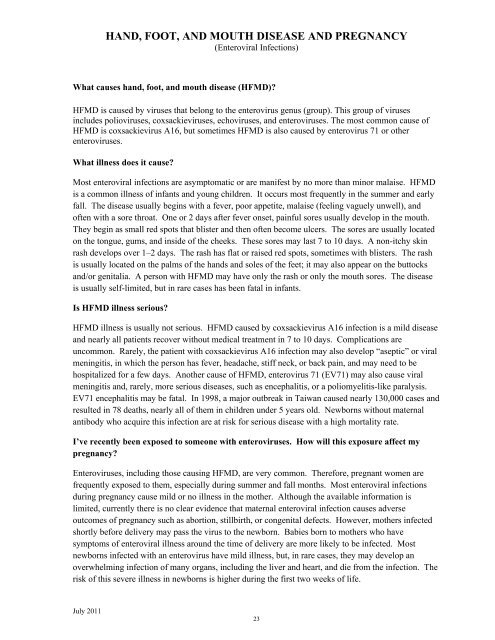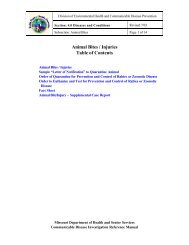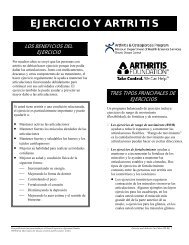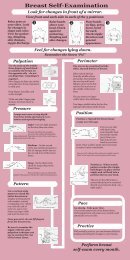Prevention and Control of Communicable Diseases - Missouri ...
Prevention and Control of Communicable Diseases - Missouri ...
Prevention and Control of Communicable Diseases - Missouri ...
Create successful ePaper yourself
Turn your PDF publications into a flip-book with our unique Google optimized e-Paper software.
July 2011<br />
HAND, FOOT, AND MOUTH DISEASE AND PREGNANCY<br />
(Enteroviral Infections)<br />
What causes h<strong>and</strong>, foot, <strong>and</strong> mouth disease (HFMD)?<br />
HFMD is caused by viruses that belong to the enterovirus genus (group). This group <strong>of</strong> viruses<br />
includes polioviruses, coxsackieviruses, echoviruses, <strong>and</strong> enteroviruses. The most common cause <strong>of</strong><br />
HFMD is coxsackievirus A16, but sometimes HFMD is also caused by enterovirus 71 or other<br />
enteroviruses.<br />
What illness does it cause?<br />
Most enteroviral infections are asymptomatic or are manifest by no more than minor malaise. HFMD<br />
is a common illness <strong>of</strong> infants <strong>and</strong> young children. It occurs most frequently in the summer <strong>and</strong> early<br />
fall. The disease usually begins with a fever, poor appetite, malaise (feeling vaguely unwell), <strong>and</strong><br />
<strong>of</strong>ten with a sore throat. One or 2 days after fever onset, painful sores usually develop in the mouth.<br />
They begin as small red spots that blister <strong>and</strong> then <strong>of</strong>ten become ulcers. The sores are usually located<br />
on the tongue, gums, <strong>and</strong> inside <strong>of</strong> the cheeks. These sores may last 7 to 10 days. A non-itchy skin<br />
rash develops over 1–2 days. The rash has flat or raised red spots, sometimes with blisters. The rash<br />
is usually located on the palms <strong>of</strong> the h<strong>and</strong>s <strong>and</strong> soles <strong>of</strong> the feet; it may also appear on the buttocks<br />
<strong>and</strong>/or genitalia. A person with HFMD may have only the rash or only the mouth sores. The disease<br />
is usually self-limited, but in rare cases has been fatal in infants.<br />
Is HFMD illness serious?<br />
HFMD illness is usually not serious. HFMD caused by coxsackievirus A16 infection is a mild disease<br />
<strong>and</strong> nearly all patients recover without medical treatment in 7 to 10 days. Complications are<br />
uncommon. Rarely, the patient with coxsackievirus A16 infection may also develop “aseptic” or viral<br />
meningitis, in which the person has fever, headache, stiff neck, or back pain, <strong>and</strong> may need to be<br />
hospitalized for a few days. Another cause <strong>of</strong> HFMD, enterovirus 71 (EV71) may also cause viral<br />
meningitis <strong>and</strong>, rarely, more serious diseases, such as encephalitis, or a poliomyelitis-like paralysis.<br />
EV71 encephalitis may be fatal. In 1998, a major outbreak in Taiwan caused nearly 130,000 cases <strong>and</strong><br />
resulted in 78 deaths, nearly all <strong>of</strong> them in children under 5 years old. Newborns without maternal<br />
antibody who acquire this infection are at risk for serious disease with a high mortality rate.<br />
I’ve recently been exposed to someone with enteroviruses. How will this exposure affect my<br />
pregnancy?<br />
Enteroviruses, including those causing HFMD, are very common. Therefore, pregnant women are<br />
frequently exposed to them, especially during summer <strong>and</strong> fall months. Most enteroviral infections<br />
during pregnancy cause mild or no illness in the mother. Although the available information is<br />
limited, currently there is no clear evidence that maternal enteroviral infection causes adverse<br />
outcomes <strong>of</strong> pregnancy such as abortion, stillbirth, or congenital defects. However, mothers infected<br />
shortly before delivery may pass the virus to the newborn. Babies born to mothers who have<br />
symptoms <strong>of</strong> enteroviral illness around the time <strong>of</strong> delivery are more likely to be infected. Most<br />
newborns infected with an enterovirus have mild illness, but, in rare cases, they may develop an<br />
overwhelming infection <strong>of</strong> many organs, including the liver <strong>and</strong> heart, <strong>and</strong> die from the infection. The<br />
risk <strong>of</strong> this severe illness in newborns is higher during the first two weeks <strong>of</strong> life.<br />
23
















